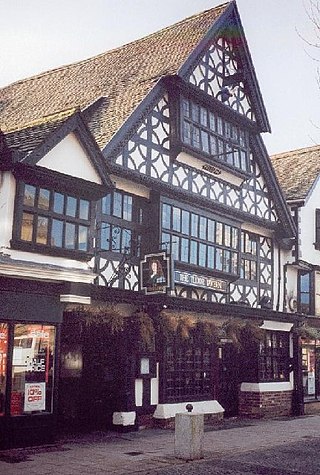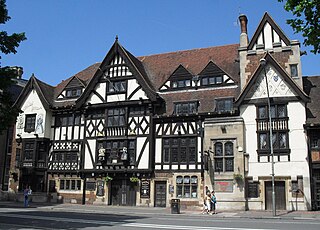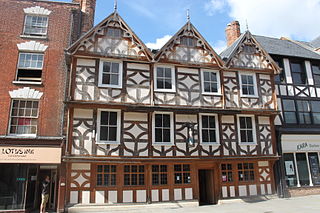
The White Hart was the personal badge of Richard II, who probably derived it from the arms of his mother, Joan "The Fair Maid of Kent", heiress of Edmund of Woodstock. It may also have been a pun on his name, as in "Rich-hart". In the Wilton Diptych, which is the earliest authentic contemporary portrait of an English king, Richard II wears a gold and enamelled white hart jewel, and even the angels surrounding the Virgin Mary all wear white hart badges. In English Folklore, the white hart is associated with Herne the Hunter.

The George Inn, or The George, is a public house established in the medieval period on Borough High Street in Southwark, London, owned and leased by the National Trust. It is located about 250 metres (820 ft) from the south side of the River Thames near London Bridge and is the only surviving galleried London coaching inn.

The King's Head is one of the oldest public houses with a coaching yard in the south of England. It is located in the Market Square, Aylesbury, Buckinghamshire, and is a Grade II* Listed Building.

The Golden Cross is a public house in Shrewsbury, England; it is reputed to be the oldest licensed pub in Shrewsbury.

The Golden Fleece is an inn in York, England, which has a free house pub on the ground floor and four guest bedrooms above. It dates back to at least the early 16th century, and claims to be the most haunted public house in York.

King John's Hunting Lodge is a wool-merchant's house built c. 1460, long after the death of King John in 1216, in Axbridge, a town in the English county of Somerset. It is a jettied timber-frame building of three storeys, occupying a corner plot on the town square. The building has served a variety of purposes with shops on the ground floor and workshops and living quarters on the first and second floors. At one time part of the building was occupied by the King's Head Inn; a sculpture of a king's head, which acted as a sign for the pub, is preserved within and a replica is attached to the outside. The lodge was bequeathed to the National Trust in 1971, and repairs were undertaken to reverse significant deterioration to the building.

The Bell Inn is a pub in Nottingham, England. Completed from around 1437, it claims, along with Ye Olde Trip to Jerusalem and Ye Olde Salutation Inn, to be the oldest pub in the city. In 1982 the pub became a Grade II listed building.

The Tudor Tavern at No 15 Fore Street, Taunton, Somerset, England has been designated as a Grade I listed building. Built in 1578, the house is three storeys high of a timber-frame construction, with jettied first and second floors. The frontage is of carved bressummers with interlocking curved braces, while the roof is red tiles. There is a medieval hall with an open trussed roof behind the front.

Regent House and Warwick House together form a large timber-framed building, probably dating from the late 16th century, in Nantwich, Cheshire, England. Regent House occupies numbers 12 and 14, and Warwick House numbers 16 and 18a, on the west side of the High Street ; Regent House occupies a bend in the street which reflects the town's Norman castle. The building was probably constructed shortly after the fire of 1583. Regent House and Warwick House are listed separately at grade II.

The Queen's Aid House, or 41 High Street, is a timber-framed, black-and-white Elizabethan merchant's house in Nantwich, Cheshire, England. It is on the High Street immediately off the town square and opposite the junction with Castle Street. It is listed at grade II. Built shortly after the fire of 1583 by Thomas Cleese, a local craftsman, it has three storeys with attics, and features ornamental panelling, overhangs or jetties at each storey, and a 19th-century oriel window. The building is best known for its contemporary inscription commemorating Elizabeth I's aid in rebuilding the town, which gives the building its name. It has been used as a café, as well as various types of shop.

The New Inn, 16 Northgate Street, Gloucester, England, is a timber framed building used as a public house, hotel and restaurant. It is the most complete surviving example of a medieval courtyard inn with galleries in Britain, and is a Grade I listed building. The announcement of Lady Jane Grey's succession to the English throne was made from the Inn gallery in 1553.

The King and Queen is a pub in the seaside resort of Brighton, part of the city of Brighton and Hove. The present building, a "striking" architectural "pantomime" by the prolific local firm Clayton & Black, dates from the 1930s, but a pub of this name has stood on the site since 1860—making it one of the first developments beyond the boundaries of the ancient village. This 18th-century pub was, in turn, converted from a former farmhouse. Built using materials characteristic of 16th-century Vernacular architecture, the pub is in the Mock Tudor style and has a wide range of extravagant decorative features inside and outside—contrasting with the simple design of the neighbouring offices at 20–22 Marlborough Place, designed a year later. English Heritage has listed the pub at Grade II for its architectural and historical importance.

The hall house is a type of vernacular house traditional in many parts of England, Wales, Ireland and lowland Scotland, as well as northern Europe, during the Middle Ages, centring on a hall. Usually timber-framed, some high status examples were built in stone.

The Golden Lion is a pub in Fulham, in the London Borough of Hammersmith and Fulham, London, England. It is located on Fulham High Street, to the east of Fulham Palace Gardens. Built in 1455 it is reported as the oldest pub in Fulham and was rebuilt by one of its Victorian owners. Notable patrons include the playwrights Shakespeare and Fletcher as well as Bishop Bonner.
The Chequer Inn is a historic 15th Century coaching house in the Conservation Area of the old market town of Steyning, in the Horsham District of West Sussex, United Kingdom. English Heritage has listed the building at Grade II for its architectural and historical importance.

The Marlborough Pub and Theatre is a historic venue, situated at 4 Princes Street, Brighton. It has been associated, since the 1970s, with the LGBT community. Until 2020, the Marlborough's small theatre presented drama, cabaret and music throughout the year, including during the Brighton Fringe Festival, LGBT History Month and Brighton Pride Arts Festival. It is colloquially referred to as 'The Marlborough' or 'The Marly'.

Robert Raikes' House is an historic 16th century timber-framed town house at 36–38 Southgate Street, Gloucester. It is now used as a public house called the Robert Raikes Inn.

The Black Swan is a public house in the city centre of York, in England. The building lies on Peasholme Green, on the site of an important Mediaeval house which had been occupied by various Lord Mayors of York and Members of Parliament. In 1560, Martin Bowes rebuilt the property, and in 1670 Henry Thompson made substantial alterations, rebuilding parts in brick, and altering the interior. Early in the 18th-century, the house was owned by Edward Thompson.

The Blue Bell is a historic pub in the city centre of York, England. The pub lies on the south-west side of Fossgate.




















